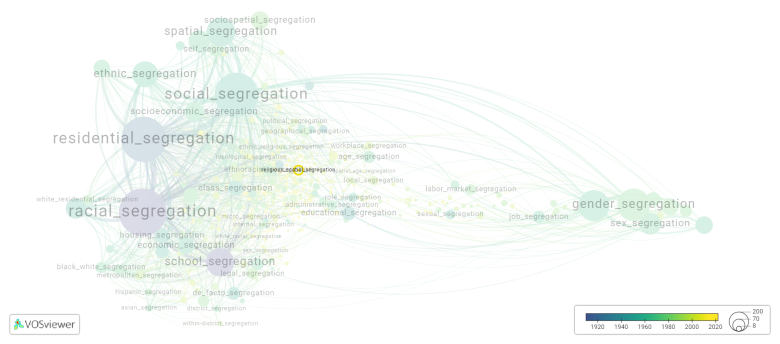Religious spatial segregation: Difference between revisions
(Creating page) |
(Creating page) |
||
| (3 intermediate revisions by the same user not shown) | |||
| Line 16: | Line 16: | ||
Efforts to promote social integration and religious tolerance often aim at reducing religious spatial segregation by creating diverse and inclusive communities. These initiatives may include policies to prevent discrimination in housing or employment, promoting interfaith dialogue, and fostering environments that encourage interaction and understanding between different religious groups. | Efforts to promote social integration and religious tolerance often aim at reducing religious spatial segregation by creating diverse and inclusive communities. These initiatives may include policies to prevent discrimination in housing or employment, promoting interfaith dialogue, and fostering environments that encourage interaction and understanding between different religious groups. | ||
==See also== | ==See also== | ||
==Related segregation forms== | |||
Religious spatial segregation is frequently discussed in the literature with the following segregation forms: | |||
[[spatial segregation]] | |||
[[File:religious_spatial_segregation.png|780x780px]] | |||
This visualization is based on the study [[Segregation_Wiki:About| The Multidisciplinary Landscape of Segregation Research]]. | |||
For the complete network of interrelated segregation forms, please refer to: | |||
* [https://tinyurl.com/2235lkhw First year of publication] | |||
* [https://tinyurl.com/2d8wg5n3 Louvain clusters] | |||
* [https://tinyurl.com/223udk5r Betweenness centrality] | |||
* [https://tinyurl.com/244d8unz Disciplines in which segregation forms first emerged (Scopus database).] | |||
==References== | ==References== | ||
==Notes== | ==Notes== | ||
Latest revision as of 07:17, 16 October 2024
Date and country of first publication[1][edit | edit source]
2022
Indonesia
Definition[edit | edit source]
Religious spatial segregation refers to the physical separation of different religious groups within a geographic area. This segregation can occur voluntarily, as communities choose to live close to others who share their religious beliefs, or it can be enforced through government policies or societal pressures.
Religious spatial segregation can take different forms, such as the establishment of religious enclaves or neighborhoods where one religious group dominates. In some cases, entire cities or regions may be predominantly populated by people of a specific religious group, leading to a spatial division along religious lines.
There are several factors that can contribute to religious spatial segregation. These include cultural and religious differences, historical conflicts, socioeconomic disparities, and the desire for religious communities to preserve their identity and practices. Some religious groups also prefer to live in close proximity to places of worship or cultural institutions that are important to their faith.
While religious spatial segregation can provide a sense of security and community for individuals belonging to a specific religious group, it can also lead to social and cultural isolation, limited exposure to other perspectives, and potential conflicts or misunderstanding between groups.
Additionally, religious spatial segregation can have implications for urban planning, public services, and resource allocation. It may impact access to education, healthcare, and employment opportunities for individuals from different religious backgrounds.
Efforts to promote social integration and religious tolerance often aim at reducing religious spatial segregation by creating diverse and inclusive communities. These initiatives may include policies to prevent discrimination in housing or employment, promoting interfaith dialogue, and fostering environments that encourage interaction and understanding between different religious groups.
See also[edit | edit source]
Related segregation forms[edit | edit source]
Religious spatial segregation is frequently discussed in the literature with the following segregation forms:
This visualization is based on the study The Multidisciplinary Landscape of Segregation Research.
For the complete network of interrelated segregation forms, please refer to:
References[edit | edit source]
Notes[edit | edit source]
- ↑ Date and country of first publication as informed by the Scopus database (December 2023).
At its current state, this definition has been generated by a Large Language Model (LLM) so far without review by an independent researcher or a member of the curating team of segregation experts that keep the Segregation Wiki online. While we strive for accuracy, we cannot guarantee its reliability, completeness and timeliness. Please use this content with caution and verify information as needed. Also, feel free to improve on the definition as you see fit, including the use of references and other informational resources. We value your input in enhancing the quality and accuracy of the definitions of segregation forms collectively offered in the Segregation Wiki ©.
Religious spatial segregation appears in the following literature[edit | edit source]
Laila N.Q., Abdullah I. (2022). Questioning Fiqh Muamalah of Toleration: Religious Spatial Segregation in the Urban Area of Yogyakarta. Al-Ihkam: Jurnal Hukum dan Pranata Sosial, 17(1), 28-59. Faculty of Shariah Institut Agama Islam Negeri Madura.https://doi.org/10.19105/AL-LHKAM.V17I1.5419

